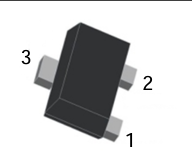Input and Output Coupling
Date:2025-05-28 Categories:Product knowledge Hits:533 From:Guangdong Youfeng Microelectronics Co., Ltd
To connect the transistor to the input signal source and output load without disturbing the biasing, use coupling capacitors (Cin and Cout). These capacitors block the DC component while allowing the AC signal to pass through. The value of the coupling capacitor depends on the lowest frequency of the input signal, calculated as C = 1 / (2πfR), where R is the input or output resistance. For example, for a 100Hz signal and a 10kΩ input resistance, Cin = 1 / (2π10010000) ≈ 0.16μF, so a 0.22μF capacitor can be used.
small signal transistorStability and Protection
To prevent oscillations in high-frequency applications, add a small bypass capacitor (typically 0.1μF) across RE to bypass the AC signal around the emitter resistor. For protection against voltage spikes, especially in switching applications, place a diode across inductive loads connected to the collector to clamp the voltage and prevent damage to the transistor.
small signal transistorPractical Applications
Audio Amplifier
In a simple audio amplifier circuit, a
small signal transistor like the 2N3904 in common emitter configuration can amplify audio signals from a preamplifier stage. Proper biasing ensures the transistor operates in the linear region, minimizing distortion. The input signal from a microphone is coupled through a capacitor to the base, and the amplified output is taken from the collector to drive a speaker through an output capacitor.
Signal Switching
small signal transistor can also be used as switches in digital circuits. When the base is driven with a high voltage (above VBE), the transistor turns on, allowing current to flow from collector to emitter, acting as a closed switch. When the base voltage is low, the transistor turns off, blocking the current, acting as an open switch. For example, a BC557 PNP transistor can be used to switch an LED on and off with a digital signal from a microcontroller.
Temperature Sensor Interface
In a temperature sensing circuit, a thermistor can be connected in the emitter bias network of a transistor. As the temperature changes, the resistance of the thermistor changes, affecting the biasing of the transistor and thus the collector current, which can be measured and converted to a temperature reading.
Troubleshooting Common Issues
If there is no output signal, verify the power supply, connections, and coupling capacitors for proper polarity and functionality.
By following these guidelines, you can effectively use
small signal transistor in various electronic circuits, ensuring optimal performance and reliability. Always refer to the transistor datasheet for specific parameters and maximum ratings to avoid damaging the component.

Previous:
Classification, Structure, and Principle of MOSFET
Next:
How to Use Power Transistors
